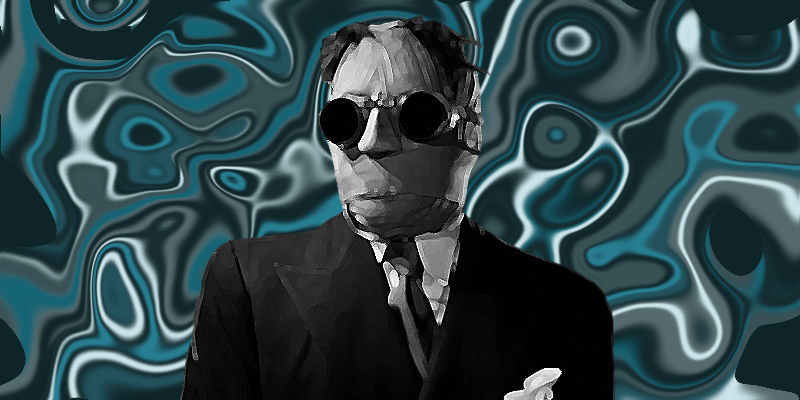I wish so badly that I could have seen The Invisible Man in 1933 when it premiered in theaters. The film is a carnival of early special effects, a parade of parlor tricks and stage magic and photographic tricks. To see it for the first time, unburdened by the knowledge of a century’s worth of innovations in those fields, must have been an experience like no other. The film must have seemed a wonderful, eerie phantasmagoria. Mordaunt Hall, the New York Times film critic at the time, extolled the film as a visual treat. “This eerie tale evidently afforded a Roman holiday for the camera aces. Photographic magic abounds in the production, the work being even more startling than was that of Douglas Fairbanks’s old picture ‘The Thief of Bagdad,'” he wrote. “The story makes such superb cinematic material that one wonders that Hollywood did not film it sooner. Now that it has been done, it is a remarkable achievement.”
But I should not bemoan my temporal circumstances too much; watching The Invisible Man today, it’s impossible not to gasp, not to grin, not to jump, at the film’s cavalcade of visual legerdemain. Time and time again, I found myself asking, as I might have as an audience member in 1933, “how did they do that?” Directed by James Whale and produced by Carl Laemmle, The Invisible Man is indeed as much of a triumph today as it was when it premiered, with the additional coup of reminding us about the possibilities of manual special effects and physical production design.
The narrative, based on the 1897 novella by H.G. Wells and adapted by R.C. Sherriff (with additional scriptwork by Preston Sturges and Philip Wylie), makes for an effective manhunt movie, but the story is more a vessel for its visual achievements. The titular invisible man is a scientist named Dr. Jack Griffin, whose experiments with chemicals turns him invisible and cause him to go mad. Once obsessed with finding an antidote to his condition, he soon becomes a power-hungry, homicidal maniac, wreaking havoc on society every way he can. He’s unseeable, but more importantly, he’s unbelievable, so he’s uncatchable.
As Griffin, Rains is a delightfully sinister loose cannonClaude Rains, a well-respected stage actor at the age of forty-four, made his film debut as Griffin. Logically, Rains is barely seen in the film. Griffin covers his face in bandages and dons layers of clothing to make his figure visible to those around him; to make himself invisible, he removes all of that fabric. The invisibility effects were achieved by having Rains wear clingy black fabric over his skin and perform in front of a matching matte black background. Whatever clothes he wore on top appeared to be moving all by themselves. These scenes were then composited onto the shots of the sets with the reacting actors. And for these scenes, Rains provided Griffin’s speech (and trademark maniacal laughter) through voiceover. This means that for the entire film, Rains performs while thoroughly concealed. And yet, he makes an enormous impression.
As Griffin, Rains is a delightfully sinister loose cannon, rolling his “r”s and pronouncing each and every syllable of his dialogue devilishly and deliciously (in a manner which calls to mind the elocutonary styles of Vincent Price, Rains’s contemporary in film but only as a background actor; he had not found his way to horror yet, as Rains had). For a figure who is technically visually absent, Rains’s presence is solid and powerful.
Gloria Stuart (whom modern audiences may know better as the later-in-life Rose in James Cameron’s 1997 Titanic) plays Flora, the woman he loves, and the daughter of his former employer, Dr. Cranley (Henry Travers). Flora is the only person who can remind Griffin of the man he once was, but his derangement has gone too far. He’s too dangerous for redemption.
“We’ve got a terrible responsibility. He’s mad, and he’s invisible.”Wells’s novella, which was first published in serialization in Pearson’s Weekly before it was republished as a single volume, is a late Victorian Young Adult novel. It was subtitled, “A Grotesque Romance.” Its design for slightly younger readers is suggested by its clear moral; it is an Icarus story, about a man whose single-minded desire for achievement and notoriety took him to new heights of discovery, ones which would in turn lead to his demise. But Wells’s novella also aims towards a kind of realism, launches the kind of imaginative scientific conjecture that Wells had undertaken in his fiction numerous times before. In the original story, Griffin studies optics and is experimenting with what might happen if he could “lower the refractive index of a substance, solid or liquid, to that of air.” He discovers a chemical that can do this to the human body, preventing it from absorbing or reflecting light and therefore causing it to appear invisible.
Whale’s film is less concerned with proposing scientific possibilities, leaning into the drama of the story. The thesis of the film is uttered by a police officer to his crew of many uniformed constables: “We’ve got a terrible responsibility. He’s mad, and he’s invisible.” There’s something to be said for that kind of straightforwardness. It’s easy for Universal Studios’s horror movies of the 1930s to seem neutered in their menace by the simple passing of time; as much as I love Tod Browning’s 1931 Dracula and James Whale’s 1931 Frankenstein (and the actors who played the monsters in those films, Bela Lugosi and Boris Karloff), those movies do feel very wedded to their specific cultural moments. But, perhaps because of Rains’s commanding performance or the no-frills danger of the plot or even the impressiveness of the special effects, I find The Invisible Man very effective, even in a way that passes for modern. A 2020 remake, written and directed by Leigh Whannell, which casts the action in a shade of #MeToo is a literal modernization of the story, but that only further nods to the timelessness of the original story, altogether.
But if you’re going to watch a movie, this Halloween season (or really any other season), make it this tidy little treat from 1933. Running an hour and 11 minutes, but packed with dazzling effects and propelled by a powerhouse performance by Rains, it’s a wonderful demonstration of the, well… I’ll just say it, magic of movies.

















